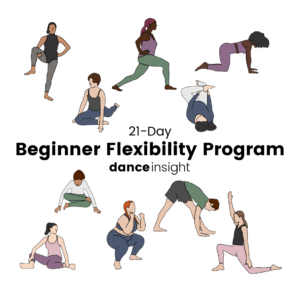
Do You Need a Website as a Professional Dancer?
This post may contain affiliate links. If you click on one of these links and make a purchase, we may earn a small commission at no additional cost to you. All affiliate links are marked with an asterisk.
Dancers don’t get jobs the same way that most people do. To get a typical 9-to-5 job (I cringe at the thought), applicants send in a resume and cover letter, some get picked for a phone interview, and the finalists get a second interview in person. Everything’s digital until the very last round, where employer and employee finally meet face-to-face.
In dance, it’s the complete opposite. Applicants show up in person to the audition (yes, you an send a reel, but they always prefer to see you live), some get picked for a callback which is, again, in person, and only the finalists get their resumes, reels, social media profiles, etc. inspected.
This is why I used to think professional dancers didn’t need websites. No one has time to click through the portfolio of every applicant when they can decide yes or no within two 8-counts of watching you dance. Maybe it would be useful if you’re famous, but not for little people like me.
Your Website Probably Won’t Get You a Job (on its own)
Just having a website doesn’t mean anyone will read it. For the first couple months after publishing Dance Insight, I was lucky to get one visitor a day. Your beautiful website that you put so much effort into will be quite lonely unless you direct people to go look at it.
While it would be a dream to publish a dancer website and just start getting emails with job offers, that’s not how it works. Your website alone won’t get you a job. Your dancing is what gets you the job, and that’s how it should be.
But here’s Why You Should Still Have One
If I’ve convinced you that you don’t need a website, don’t stop reading yet. Your website won’t get you a job on its own, but there are plenty of reasons why you should have one anyway.
It was a quote from a Dance Spirit article that sold me on the idea of a professional dancer website:
If anyone looks me up, the first thing they see is something I have control over.
Have you ever tried to look up a business only to find that they don’t have a website, or even a Facebook page? (Yes, those places still exist!) Frustrating, right? As a professional dancer, you are a business, and you don’t want to be that person without an online presence.
Google is Not Your Friend
Imagine you’re one of three dancers under consideration to be cast in a dance company. To decide between you, they want to take a look at your previous work. The other two finalists have their website addresses in their resumes, but you don’t, so they Google you. This wouldn’t be a bad situation if you have a thriving YouTube channel or thousands of followers on Instagram. That’ll show up in a Google search and they’ll see how cool you are. But what if you don’t have those things? What will they find?
When I Google my name right now, I get a bunch of other people who aren’t me. Even when I include the word “dance,” all you get is my Instagram profile on the third hit. It didn’t find my bio at the studio where I teach, my YouTube videos, or the article about me in the newspaper (to be fair, that was in high school). I have stuff out there, but Google didn’t find it. If I was the person in the scenario above, I would probably not have been cast.
Google is unpredictable. It shows different stuff to different people based on their search history, cookies, and who knows what else. Their algorithms change all the time. Don’t rely on Google to show people what you want them to see.
Create an Online Space that You Control
You are in complete control of your own website. Just like your resume, you can put your best work in a prominent place and omit anything that’s not important. Yes, it probably won’t show up in a Google search, but that won’t matter if you have the link printed on your resume, so people can go there directly.
It might seem like a lot of work to create a website for a “just in case” scenario, but once you’ve done the initial setup, maintaining a website really isn’t that hard or time-consuming. And it may not be “just in case” for long. I have a feeling the Internet isn’t going away, and it’s only going to become more essential as time goes on.
Tips for Making Your Professional Dancer Website
I have a degree in web design as well as dance, so I thought I’d share a few tips for how to make your website stunning. It’s not hard at all to get your information up there in a concise and visually appealing way. You don’t even need to know how websites work!
There are hundreds of tutorials for how to get your website up and running that are just a search away. I’ll save you the repetition and get straight to the tips.
Buy a real “.com” name. (Domain name)
You can make a website for free, but the free versions are never just www.yourname.com. It’ll be something like yourname.websitecompany.com/site1. Not nearly as pretty. I’m not gonna lie, though. It costs me about $120 a year to own and use the name dance-insight.com. That’s not cheap when you’re on a “starving artist” budget.
Even so, I recommend investing in your own domain name if at all possible. Consider it an expense along the same lines as getting headshots taken or paying for dance classes. It’s part of your career. If any of your dance jobs pay you as a 1099 independent contractor, you might even be able to write it off as a business expense on your taxes.
The problems with free domain names are:
- It looks cheap and amateur to have another company’s name in your web address. The domain name is one of the first things visitors see, and you want that first impression to be clean and professional.
- If you ever decide to upgrade to a paid domain name, it’s not as simple as just “renaming” your website. Your “.com” name is more than just a name. It’s your website’s address on the Internet. You actually have to move all your content to a new address, and that takes some technical skill. It’s much easier to have a paid domain name from the start, so you never have to move your content.
- Not only do you have to move your website to a new address when you upgrade, but you also have to do something called redirecting. Let’s say you’ve been including your website on your resume. When you upgrade to a paid domain name, all of a sudden the old links won’t work. Someone tries to go to yourname.websitecompany.com/site1 and they get a “page not found” error, because your website is at www.yourname.com now. Redirecting, which has to be done manually and requires technical skill, is when you make it so that anyone who visits the old domain name is automatically redirected to the new one. That’s another headache you don’t want to go through. Save yourself the trouble and get a paid domain name from the start.
Put All Important Information and Links on the Front Page
In the event that a casting director, talent scout, agent, or other important person looks at your website, they will NOT have the patience to search, scroll, click around, etc. looking for what they need. Without crowding, try to have everything visible on the home page, or clearly marked in a tab. Make sure to include:
- Your full name and an introductory sentence saying who you are/what you do, i.e. “I’m a dancer, actress, and model based in Brooklyn.”
- Your headshot and/or dance shot
- A link to your reel(s)
- A link to your resume, or to a page with a summary of your work
- If you have any production shots or videos, link to a gallery with brief descriptions of each project
- A contact form or your email address
- (Optional) If you know you’re booked for the next 6 months to a year (lucky you!), consider including a statement to that effect on your website. You don’t have to flat out say “don’t hire me, I’m booked,” but you could have sections for “what I’m up to currently” and “where I’m headed next.” If someone sees that you have three things lined up after your current contract, they’ll get the picture. But they’ll still get a great impression of you because they’ll see you’re in demand!
Keep it Current
Maybe this is the web designer in me, but nothing bugs me more than when a website hasn’t been updated. When I see “Come see my show in December [3 years ago],” I’m left wondering. That show was in the future the last time they updated their website, so what have they been doing the last 3 years? Did they go into hiding?
Even if the information’s up to date, you have to keep the website looking modern. I’m sure you’ve seen those websites that look like they were designed in 2005. Brightly-colored text boxes, decorative borders, pixely photos, and nothing scales properly to fit on your phone. Today’s website templates don’t look like that, of course, but web design trends change rapidly. In a few years, the clean, beautiful website that you put together will look outdated. Templates (see below) make it easy to give your website a makeover without having to retype everything, so it’s really not hard to keep it looking fresh!
I also recommend refreshing your home page photos at least once a year. If you keep the same pictures up for too long, returning visitors will always see you doing the same thing, and it might look like you haven’t been active in the field.
Use a Template
Whether you’re using WordPress, Squarespace, Wix, or any other website builder, you will have the option to build your website from a template. Do it. Those templates are made by professional web designers, and you have enough options to choose from that you don’t need to worry about your site looking like everyone else’s. Using a template gets you professional quality design without paying for a professional designer.
You might be tempted to design the site yourself using a drag-and-drop builder. I strongly caution against this.
- It’s not going to turn out how you want. Drag-and-drop builders are limited in what they allow you to edit, and chances are your vision won’t line up with what they allow you to do.
- It’s hard to make a website look good. I have a degree in web design and I use a template for Dance Insight. Unless you have some serious design skills, what you think looks good probably looks meh to other people. Meh isn’t good enough. Your website should be as professional as your dancing.
So there you have it. If you buy a real domain name, put all important information on the front page, keep it current, and use a template, you will have a spectacular dancer website. Now please excuse me while I go create mine…







